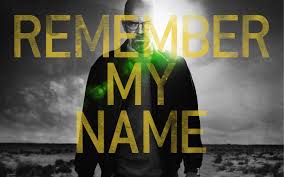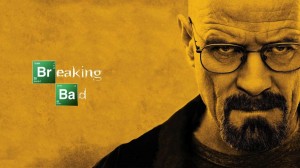The Pathos of Breaking Bad (Part 4)
By Asher Crispe: February 20, 2014: Category Inspirations, Quilt of Translations
 Humans are adhesive. We walk through life with events, places, people, and the plastic parts of our experience somehow sticking to us. What an accumulation it is! Sometimes our old identities get plastered over with all of the multiplex of additives. The self cannot be thought of as a naked core. It is always wrapped up in what I am doing and where I am going. These extracurricular augmentations fashion me into more than myself.
Humans are adhesive. We walk through life with events, places, people, and the plastic parts of our experience somehow sticking to us. What an accumulation it is! Sometimes our old identities get plastered over with all of the multiplex of additives. The self cannot be thought of as a naked core. It is always wrapped up in what I am doing and where I am going. These extracurricular augmentations fashion me into more than myself.
Easily lost within them, they give rise to a fundamental ambiguity: who is the real me? For the Breaking Bad audience who has watched the meticulous peeling and parsing of the naive innocence of Walter White over the course of the show, the excessive pounding and mashing that coalesces into the sinister shadow figure of Heisenberg proves to be a shocking transformation. Like the cancer his body is afflicted with, his original character is continually being taken over by his malignant new alias. The infamous bold capital letters of ‘Heisenberg’ slowly eclipse the feeble lower case letters of ‘Walter White’.
So why choose the name Heisenberg to represent the ‘bad’ persona?
To properly respond to such a question, it helps if one is aquatinted with the original Heisenberg–Werner Heisenberg (1901-1976)–the quantum physicist who is best known for formulating the Uncertainty Principle in quantum mechanics. The Uncertainty Principle argues that there are limits to knowing both the position and momentum of a sub-atomic particle. Moreover, according to Heisenberg, this is not merely a epistemological limitation of the human condition but rather, it is an ontological feature of the universe. In other words, the difficulty results from a basic feature of nature and not merely some shortcoming of human knowledge.
The more precisely we define the position of the sub-atomic particle, the less precisely we know how it is moving (or specifically its momentum–the product of its mass and velocity). Likewise, the reverse holds true: the more we know about the momentum of the sub-atomic particle, the less we can know about its position. The ‘uncertainly’ in a quantum mechanical system therefore challenges us to work with incomplete information.
As far as scientific revolutions are concerned, nothing has blasted the classical deterministic view of a mechanistic universe out of the water quite like quantum theory. Armed with the Uncertainty Principle, we have ushered in the probabilistic turn in physics. This new found ‘freedom’ lurks in the uncertainty itself. It means that the response to the same inputs or stimuli will not necessary lead to the same results.
Many have tried to apply the implications of this and other theories in physics to the realm of human psychology. Chassidic philosophy first and foremost advocates such an approach. For every spiritual lesson there must be an analogue in both the psyche and the physical universe. In the original terminology, everything that manifests in terms of Divinity (Elokut) must also be expressed in parallel in souls (neshamot) and in worlds (olamot). With this in mind, we may inquire into the intrapersonal and interpersonal applications of the Uncertainly Principle.
People often ask themselves: ‘where am I holding?’ seeking to identify themselves in terms of placement. ‘Status’ reports often emphasize stasis while dropping a pin to get a fix on my location. In the logic of placement, ‘where I am at’ is all that matters. When we speak about being a ‘good person’ or a ‘bad person’ we are focusing on our situatedness in timeless, frozen landscape. We are presenting ourselves a being in a certain manner. These determinations effectively arrest our development. If I am a certain way (and I am certain that I am that way), then it might not matter what I do. Thinking along these lines, I could come to disassociate myself from my actions by simply brushing them aside with the excuse that they don’t reflect who I really am.
On the other hand, ‘ways’ of being does not only imply positional consciousness. The ‘way’ also carries an alternative significance of the road one is traveling along. Questions of position automatically solicit questions of momentum as I change position. Reflecting upon my movements emphasizes my sense of becoming rather than being.
We are subjects that are subject to change. We can’t be precisely located. The more we concentrate on our own evolution—the trajectory we are passing along through our well-intended journeys and sometimes hapless misadventures—the less we are able to determine our position in life. Mired in the uncertainly over where I am and where I am going (goal verses process) we are cast in self doubt. A person might take advantage of this indeterminate sense of self to spin positive any personal assessments–to find reason for hope and improvement–or, it is equally possible for a person to stumble into a downward spiral of negativity as if lack of certainly were proof for the most cynical and pessimistic of attitudes.
Where do we find an articulation of Heisenberg’s Uncertainly Principle in traditional Jewish texts? We need look no further than the book of Job (28:23) where it states that “God understood her path, and He knows her location [אלקים הבין דרכה והוא ידע את מקומה].” Deciphering one’s path entails an awareness of momentum and velocity, while location reflects a knowledge of position. While we might be excluded from simultaneously knowing both, this is not true according to this verse for God. Divine tracking of where we are, where we are heading, and how we are getting there is no problem. This issue resides solely on this side of creation ‘east of Eden.’
One explanation for the difference between human and Divine capabilities in this regard stems from our first episode of ‘breaking bad’ in the Torah–namely the eating from the Tree of Knowledge of Good and Evil. The primordial serpent who coaxes us into eating from this tree is called a nachash in Hebrew which itself means ‘guessing’ or by extension states of uncertainty, ambiguity and doubt. The poison of the snake can be thought of as the introduction of Heisenberg’s Uncertainty Principle into the natural world. Subsequently, we were only able to precisely know either the path or the location but not both at the same time. With this, Good and Evil became mixed up in one another, which of course (as history can attest) has resulted in the production of further episodes of ‘breaking bad’.
Walter White becomes the anathema via the uncertainly of Heisenberg. The lack of complete information and controlled conditions outside of the chemistry lab continuously spoil the plans of this artless criminal. The causal train which supposedly connects his initiatives to anticipatable outcomes has run away and jumped the tracks. No one can master all of the variables. We catch sight of our first ‘break’ when the clouds of uncertainly descend upon our actions and envelope the self. Consequently, most outside observers do not recognize that the man known as Walter White is also the same man who has, in a kind of self-mocking irony, come to rename himself after the very condition which permits his self-deterioration–the cancerous Heisenbergian uncertainly.
What would rabbinical counsel offer Walter White (both the fictional character on the show and the mini-figural within the dark side of the human psyche)?
 The key to the cure lies in the heart of the disease itself. If we and the most basic properties of our reality are uncertain—if they are indeterminate—then we are empowered to direct matters in any which way we choose. For the Torah, the imperative to choose Life and pursue the Good directs us through a lack of clarity. It would be a mistake to associate the unknown with negativity. Not knowing where I am continuously holds out the promise of finding myself somewhere better, and not knowing my path assures me that I am not moving along a predetermined course. No one may chart my next move based on my ‘priors.’ I may alter both my path and position.
The key to the cure lies in the heart of the disease itself. If we and the most basic properties of our reality are uncertain—if they are indeterminate—then we are empowered to direct matters in any which way we choose. For the Torah, the imperative to choose Life and pursue the Good directs us through a lack of clarity. It would be a mistake to associate the unknown with negativity. Not knowing where I am continuously holds out the promise of finding myself somewhere better, and not knowing my path assures me that I am not moving along a predetermined course. No one may chart my next move based on my ‘priors.’ I may alter both my path and position.
To this end, there are countless instances in Kabbalah and Chassidic philosophy where the original human drama of ‘breaking bad’ with the encounter with the primordial serpent is also an allusion to the ultimate cure. Just as a good pharmacist knows how to work with a delicate balance of poisons in order to effect the much needed remedy, so too Messianic redemption traces its rectifying power back to a common denominator with its opposition. In Hebrew our Edenic nachash (snake נחש) equals 358 which is the precise value of the word Moshiach (messiah משיח). The implication of this is that Moshiach will utilize the very same uncertainty that resulted in our ‘breaking bad,’ only it will be repurposed towards good means and ends.
We can be otherwise because we are continuously becoming. We make our way. It need not be cut before us. ‘Not knowing’ has its advantages if only we can learn to recognize it as such. The yoke of remaining undefined propels us to carefully weigh and own our actions for through them we may acquire any semblance of definition.
http://www.interinclusion.org/inspirations/the-pathos-of-breaking-bad-part-3/
http://www.interinclusion.org/inspirations/the-pathos-of-breaking-bad-part-1/
The Pathos of Breaking Bad (Part 4),















;)
;)
;)
;)
;)
;)
;)
;)
;)
;)
